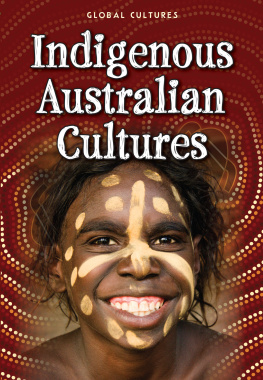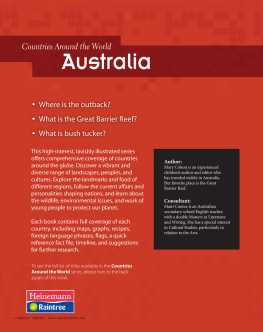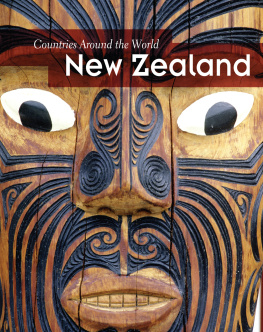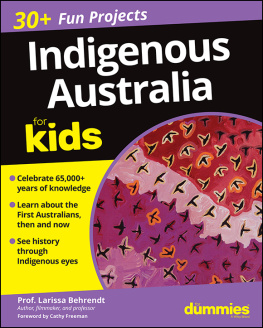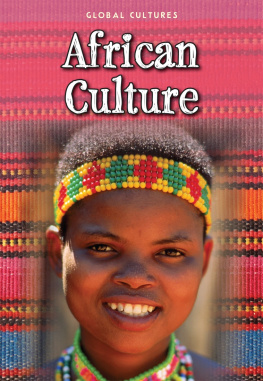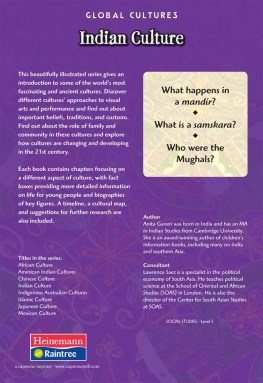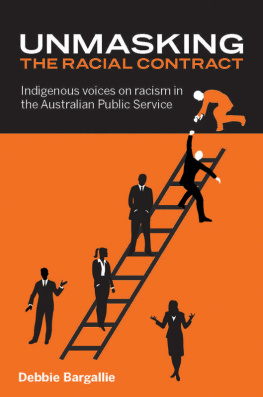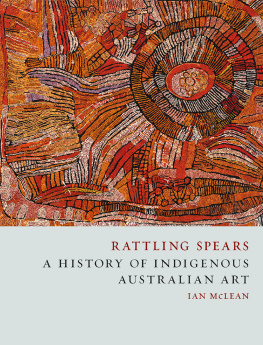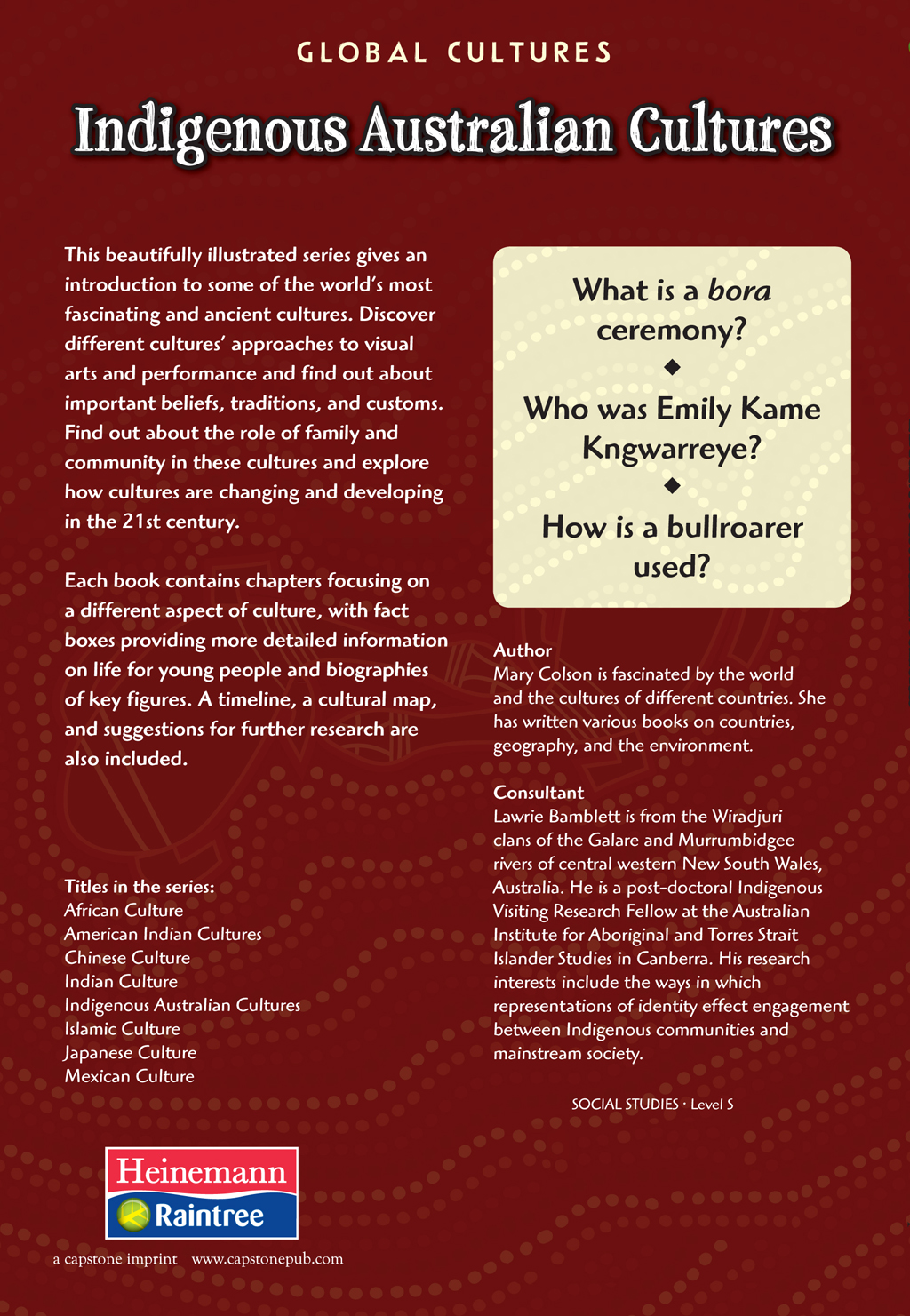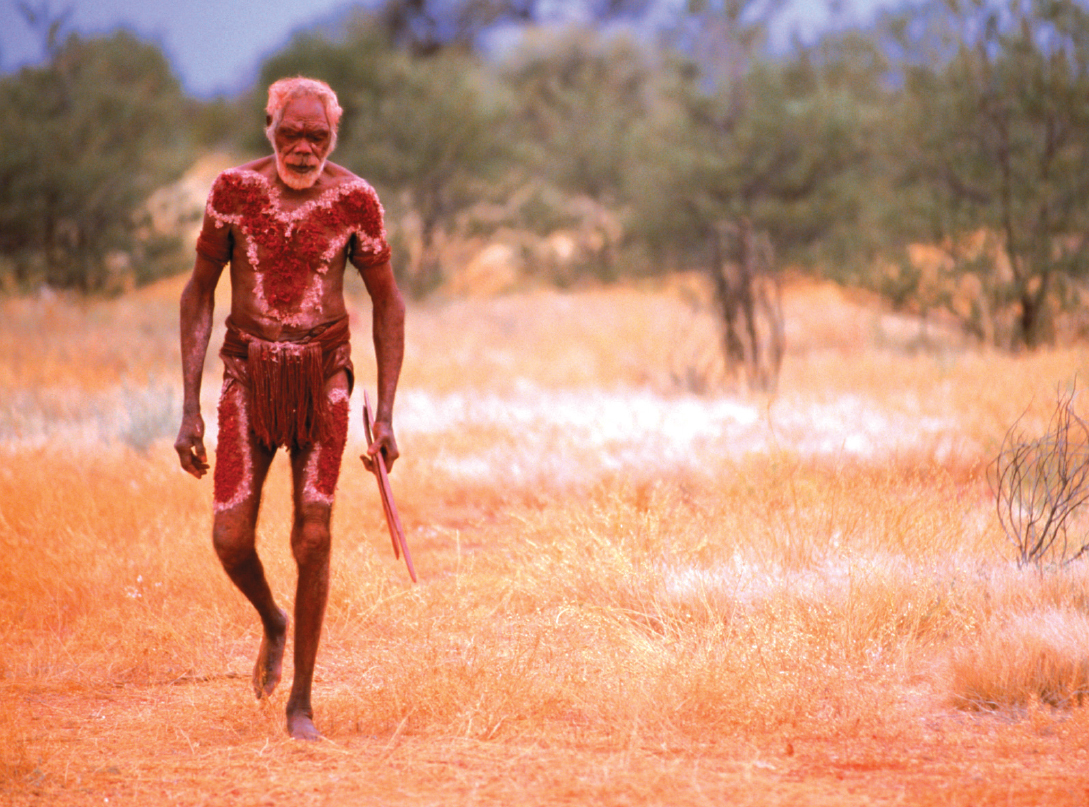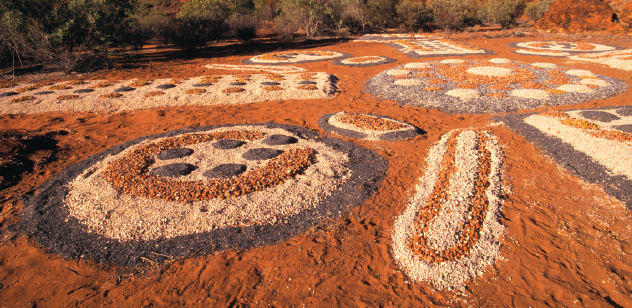FIND OUT MORE
Books
Bingham, Jane. Aboriginal Art and Culture (World Art and Culture). Chicago: Raintree, 2005.
Bingham, Jane. Living in the Australian Outback (World Cultures). Chicago: Raintree, 2008.
Colson, Mary. Australia (Countries Around the World). Chicago: Heinemann Library, 2012.
Haywood, John. Australian Aborigines (Early Peoples). Chicago: World Book, 2009.
Websites
www.aiatsis.gov.au
Visit the website of the Australian Institute for Aboriginal and Torres Strait Islander Studies.
australianmuseum.net.au/Indigenous-Australia
Learn more about topics related to Indigenous Australians, including spirituality, cultural heritage, the land, and more.
burarra.questacon.edu.au/home.html
Meet Danaja and his grandfather, Wala Wala, and find out about life in an Indigenous Australian community.
www.nla.gov.au/exhibitions/bunyips
Are you scared of bunyips? If you dare, check out the National Library of Australias web site for stories, games, and quizzes.
CDs and DVDs
Rabbit-Proof Fence (2002)
The Rough Guide to Australian Aboriginal Music (World Music Network, 2008)
Places to visit
The Kluge-Ruhe Aboriginal Art Collection of the University of Virginia, Charlottesville, Virginia
This is the only museum in the United States dedicated to Indigenous Australian art.
If you ever get the chance to visit Australia, these are some places you could visit:
Brambuk National Park and Cultural Center, Victoria
This cultural center is shared by five indigenous communities.
Take a bush food tour and try eating crocodile and kangaroo!
Kakadu National Park, Northern Territory
See rock art images of spirit ancestors and hunting in this spectacular landscape.
Tjapukai Aboriginal Cultural Park, Cairns, Queensland
Watch theater and dance performances and learn the traditional ways of the Tjapukai people. Make bush medicines and learn to play the didgeridoo.
Uluru, Northern Territory
Visit Australias most famous rock. Take a guided tour around the sacred sites and see the amazing rock art.
More topics to research
What topic did you like reading about most in this book? Choose a topic that you liked, such as food, art, or religion, and try to find out more about it. You could take a look at one of the websites listed here or visit your local library to do some research. You could also listen to some Indigenous Australian music or make a dot painting on tree bark.
INTRODUCING INDIGENOUS AUSTRALIAN CULTURES
What do you know about Indigenous Australian cultures ? Have you seen pictures of ancient cave paintings? Do you think of didgeridoos and people living in harmony with the land?
First people
Aborigine is a Latin word meaning from the beginning. The word was used by white settlers to describe the indigenous people of Australia and the Torres Strait Islands, located off the coast of present-day Queensland, Australia.
It is believed that Indigenous Australians came to Australia and the Torres Strait Islands 50,000 to 60,000 years ago from Southeast Asia. Indigenous Australian people believe they have always lived there, and that they were created by spirit ancestors . Europeans arrived and began settling in Australia in 1788. There have been many problems and conflicts between the two groups of people.
There are 550,000 Indigenous Australians, and they make up about 1 percent of Australias population. Each different indigenous group or nation, such as the Eora, Yari-Yarit, and Djidjijamba, has its own language. Some nations have just a few family groups, while others include hundreds of people.
Did you know?
Indigenous Australian people do not always use the word Aborigine to describe themselves. They may also use words such as Koori, Murri, and Nyungar.
What is culture?
Culture includes the values, beliefs, and attitudes of a particular place. It is about how people live and worship, and about the music, art, and literature they produce. Indigenous Australian cultures have developed over thousands of years. This book explores different features of these ancient and peaceful cultures.
Indigenous Australian cultures are some of the oldest continuous cultures in the world.
BELIEFS AND FESTIVALS
The Dreamtime is what Indigenous Australians call the beginning of the world. Their stories, art, and music explain different parts of the Dreamtime and pass on important beliefs to new generations. Dreamtime stories include why fish swim and how the landscape was created by different spirit ancestors. Each nation usually has its own spirit and creation story . However, some stories are shared, such as the story of Baiame, the creation spirit.
In the beginning
Most indigenous people believe that in the beginning, the world had no mountains, rocks, or rivers. They believe that spirit ancestors came out of the ground and began to shape the landscape as they moved. For example, a mountain may be the fallen body of a spirit ancestor. Indigenous Australians believe that some of these ancestors gave birth to humans. Spirit ancestors can be humans, animals, rocks, trees, or stars. There are ancestral kangaroos and ancestral fish.

